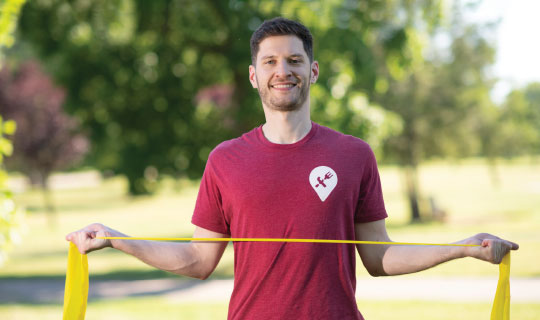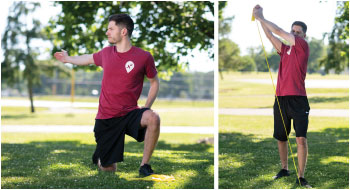“I now know that if my pain flares up, I have exercises that will bring me relief.”

David Herren, a 30-year-old Colonia resident, started experiencing chronic neck pain in his 20s. Frequent forays on the basketball court, softball diamond, flag football field and in the gym had overtaxed his upper spine and surrounding muscles, and at 26 he was diagnosed with a herniated disk—a bulging of one of the soft pads that cushion spaces between the bony vertebrae of his spine.
Herren had tried treatments ranging from cortisone injections to regional nerve blocks to dull the pain. None worked for long, and he had just started trying physical therapy. Then the COVID-19 pandemic hit.
A junior high school educator, Herren abruptly shifted to teaching from home. Changes in his work habits—now heavily oriented toward his computer— ratcheted up his pain. The tall and lanky Herren found that teaching class over Zoom, grading assignments and writing emails now triggered frequent tension headaches along with more severe neck pain and tightness that extended to his shoulders and down his arms.
“I was definitely hunched over more, leaning forward with my shoulders up near my ears,” he says. “A lot of desks aren’t made for people my height. Even sitting in bed, my neck screamed.”
A Personalized Program
Herren feared he might need neck surgery to correct his disk herniation and relieve his pain. One doctor had already recommended it—a prospect that “threw me for a loop,” Herren says. He hoped continuing the physical therapy he’d begun just before the pandemic would provide an alternative.
Geoffrey Stankus, PT, DPT, a physical therapist at Robert Wood Johnson University Hospital (RWJUH) Somerset’s Sports Physical Therapy in Princeton, understood how the pandemic lockdown had affected Herren’s condition. “It made his disk herniation a lot worse,” Stankus explains. “It was the proverbial straw that broke the camel’s back. The problem was already there, and the pandemic gave it magnitude.”
Stankus devised a personalized physical therapy regimen for Herren that focused on loosening overly tight muscles at the back of his neck while strengthening muscles in his upper back. Measures included deep tissue massage, stretching and weight lifting combined with occasional heat and ice therapy along with education about proper posture and muscle use.
“Stankus gave me handouts with directions, and once a week he’d add more exercises,” Herren says. “He started with the root of my problem—my posture—and focused on the mobility of my shoulders, then went on to rebuilding muscle.”

Carrying Lessons Forward
Stankus agreed that a noninvasive approach was preferable to surgery, which entails the possibility of complications such as infection, blood loss or nerve damage.
“Within a few weeks of physical therapy, we generally are going to know if we can make a problem better,” Stankus says. “Trying something less invasive may give you more insight into what’s causing your pain.” Physical therapy can easily be adjusted with new knowledge. Surgery, while sometimes necessary to correct neck and spine issues, is less adaptable or readily undone, he says.
Herren began seeing Stankus twice a week and generally has been able to apply newly learned exercise and stretching regimens at home. Some of the methods Herren has learned are specifically designed to accommodate a slight curvature of his spine. He’s thrilled that physical therapy has helped him avoid the operating table.
Back in the classroom as pandemic restrictions lifted, Herren continued to stretch, exercise and practice better posture while teaching again in person.
“My shoulders are feeling more open now,” Herren says. Even while still feeling a slight pulling sensation in his neck, “the severity compared to where I was is night and day,” he says. “Beyond that, I’ve noticed that certain things I couldn’t do before without pain don’t happen as much. And I now know that if my pain flares up, I have exercises that will bring me relief.”
Save Your Neck From Strain
When pandemic lockdowns eased, Geoffrey Stankus, PT, DPT, a physical therapist at Robert Wood Johnson University Hospital (RWJUH) Somerset’s Sports Physical Therapy in Princeton, found that many returning patients suffered from neck pain or strain likely linked to working or learning from home. “People were—and are—spending hours looking at phones or screens,” he says.
Some 22 muscles in the neck support the weight of the head, and every inch you shift your head forward—as when hunched over a screen—adds 10 to 12 pounds of force on your neck. Resulting strain can show up as headaches, shoulder pain, stiffness, and numbness or tingling that extends to the fingers.
To avoid such problems, Stankus suggests measures like these:
- Try to hold your head with the middle of your ear aligned with the middle of your shoulder—a neutral position that helps reduce muscle strain in the neck.
- Limit unbroken periods of screen use to 30 minutes or less.
- Change your body position or reset your posture at least every 30 minutes, especially when using devices or screens.
- Stretch your neck from side to side and back and forth frequently throughout the day.
- Drink plenty of water, which can help keep muscles and nerves working properly.
- Eat protein-rich foods, which help facilitate muscle repair.
To learn more about physical therapy at Robert Wood Johnson University Hospital Somerset, call 855-777-8763.